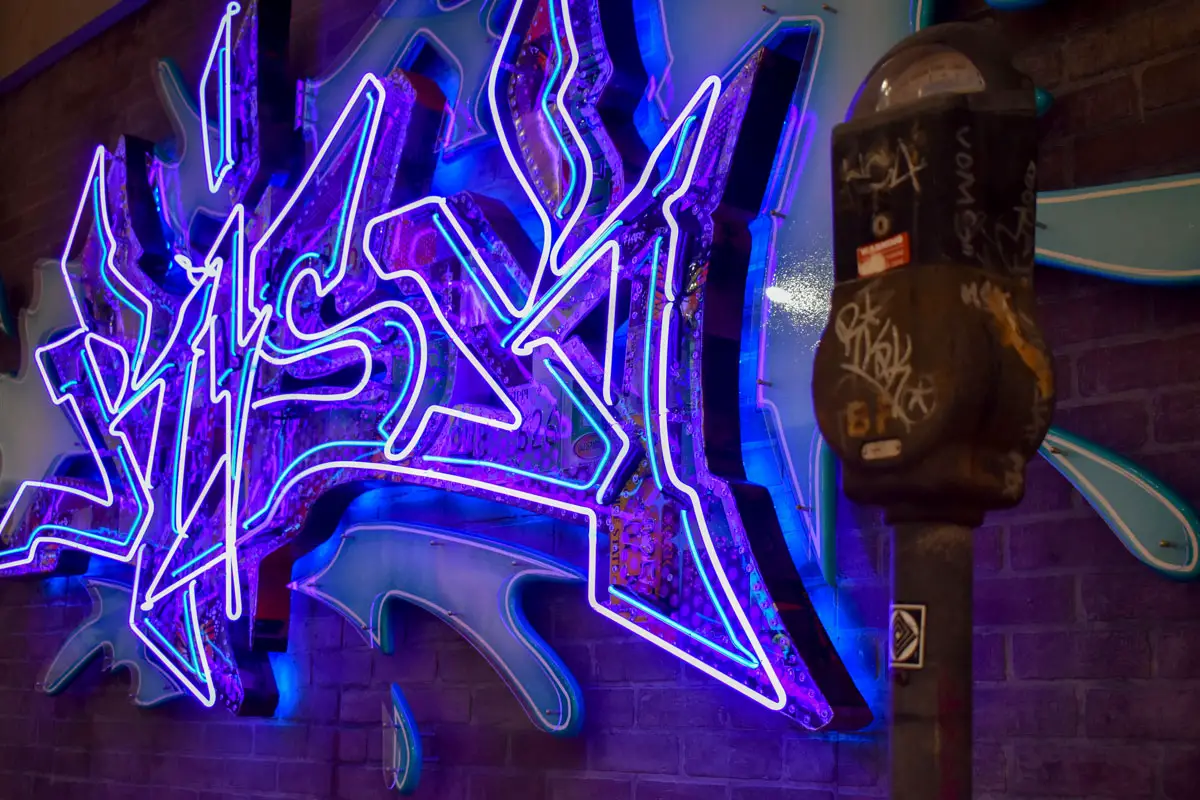ESCONDIDO — The Escondido City Council will consider a new management agreement with the California Center for the Arts several weeks after residents and elected officials expressed concerns over the venue’s showing of a controversial art installation.
The discussion of crafting a new agreement, which expired three years ago and was never renewed, comes after the arts venue opened the “Street Legacy: So Cal Style Masters” in June, highlighting Southern California’s subcultures.
The exhibition also features a controversial artwork by OG Slick, “Three Slick Pigs,” featuring three Porky Pig-style statues wearing police uniforms and dancing in front of a large black-and-white photo of Minneapolis police officers wearing riot gear.
Spray-painted on the large backdrop is the acronym “A.P.A.B.,” which stands for either “all pigs are bastards” or “all police are bastards.”
Despite some public outcry, the arts center’s board of trustees voted in favor of keeping the piece on display, offering to “take a leadership role in brokering private and public discussions among the exhibit curators, artists, city leaders, community groups and others to further public education and foster the respectful exchange of ideas.”

According to a statement released by OG Slick on Instagram, the artwork is “a satirical look at excessive police force and abuse of power by some individuals who hide behind the badge of the largest ‘gang’ in the U.S.”
Others did not appreciate the artist’s attempt at satire.
“I think it’s hate speech,” said Councilmember Mike Morasco.
Shortly after the exhibit’s opening, Morasco requested staff to bring back a “possible funding” discussion regarding the arts center. Mayor Paul McNamara added to Morasco’s request to review the management relationship between the city and the California Center for the Arts.
The council previously considered cutting the arts center’s funding in the spring to make up for a city budget deficit, but cutbacks were avoided with COVID-19 relief funds.
The city reduced the center’s funding from $1.9 to $1.5 million, including a $133,000 reduction in the management fee, intending to renegotiate the management agreement in the following months.
The city pays annual fees of approximately $810,000 for natural gas and electricity, $337,579 for maintenance and $655,370 in management fees, the latter of which is paid in two installments in July and January. The July installment was paused due to the council’s discussion.
California Center for the Arts is a nonprofit organization independent of city control. Although the city owns the building and may review and approve the center’s project schedule and facility uses, the arts center maintains control of artists, content and promotions.
However, the management agreement appears to lack shared responsibilities for both parties.
Currently, the city assumes responsibility for the center’s permanent structures, exterior building and landscape maintenance, HVAC, plumbing, elevators, fire alarms and kitchen equipment. The arts center is responsible for minor interior building maintenance, janitorial service, security alarms, plumbing fixtures and exterior cleaning.
Due to the suggestion of funding discussions, many supporters in the community feared the city would consider defunding the venue in response to the art center’s refusal to take down the controversial installation. Many comments suggested the council was trying to censor the arts center.
“This action only shuts down engagement and discussion,” said Kristen Moss, associate professor in the visual and performing arts department at the California State University of San Marcos.
McNamara assured residents he did not want to defund the center but merely wished to discuss the parameters of a new management agreement and both parties responsibilities.

“We’re not looking to cut money,” said Mayor Paul McNamara. “I support it, but I am concerned about how the money is spent.”
McNamara questioned if the city should be doing all the maintenance, while Morasco questioned why the city pays the arts center’s utility bills.
“I don’t know very many individuals who lease a property, and the owner pays the utility bills,” Morasco said.
Councilmember Joe Garcia, who served as Escondido Police Department’s chaplain for over 15 years and has two brothers who are retired police officers, was also unhappy with the piece and the center’s response.
As part of the soon-to-be new management agreement, Garcia wants to see quarterly reports of activities going on and funding to the center divided into portions that are given to specific areas – mainly to the center’s performing arts department and its Tierra Caliente Academy of Arts, a nonprofit dance organization based in the center. Garcia also wants to have more “open dialogue with the center.”
Garcia noted he has been a 25-year resident of Escondido and didn’t know the center had an art museum, suggesting the center’s marketing strategies had failed.
McNamara and Garcia also claimed the piece offended more people than what some of the public speakers present at the meeting suggested. Garcia said he had many people approach him demanding the city defund the center. However none of the 20 public comments on Aug. 1 reflected that sentiment and demanded the city keep funding in place or increase it.
According to Deputy Mayor Tina Inscoe, all council members have attended the exhibit and have seen the installation, noting the installation has been “extremely successful.”
Councilmember Consuelo Martinez said she found the timing of the discussion disappointing, considering it followed the council’s approval of the city budget in June, which includes the center’s funding.
“The timing seems very retaliatory,” Martinez said. “It caused a lot of angst and upset the community.”
Martinez noted she did not share the same reaction to the installation as several of the other council members had due to her own lived experiences as well as her exposure to graffiti and Chicano street art over the years.
Both Inscoe and Martinez agreed the management agreement needed to be updated.
The “Street Legacy” exhibit will remain on display until Aug. 28.



